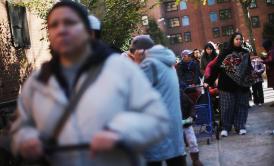As 1.9 million remained without electricity Sunday, half of whom were in New Jersey, regional officials began to focus on how the weather could affect those who are still without heat and even shelter. New York Mayor Michael Bloomberg said that as many as 40,000 people will need to find new homes as temperatures in the region fell into the 30s, reports the New York Times. Officials are urging those without power to head to shelters as the National Weather Service issued a freeze watch for parts of New Jersey. New York has opened warming shelter and the city is distributing blankets for those who refuse to leave their homes. “This is going to be a massive, massive housing problem and you’re going to need a number of options for a number of situations, short term long term,” New York Gov. Andrew Cuomo said, reports the New York Daily News.
“You can die from being cold,” Bloomberg said Sunday. “You can die from fires started from candles or stoves. Please go to the local disaster site. If you don’t know where to go, stop a cop on the side of the road and ask.” The frustration continued to grow amid those struggling in the storm’s aftermath. Bloomberg got a first-hand look at that frustration when he went on an unscheduled visit around the Rockaway Beach section of Queens Saturday and was challenged by residents demanding more assistance, reports the New York Post. (Watch video of the visit after the jump.)
Amid the devastation there was also an outpouring of goodwill as more than 1,000 people, many of whom were scheduled to run the marathon, traveled to Staten Island Sunday to provide supplies and assistance to residents, reports Reuters.
For now, power has returned for around 77 percent of the 8.5 million customers who lost electricity during the storm, reports Bloomberg. Yet utility companies warned some people might not get power for another two weeks. Superstorm Sandy caused the greatest devastation the region’s power industry has ever seen, an industry insider tells Bloomberg.
